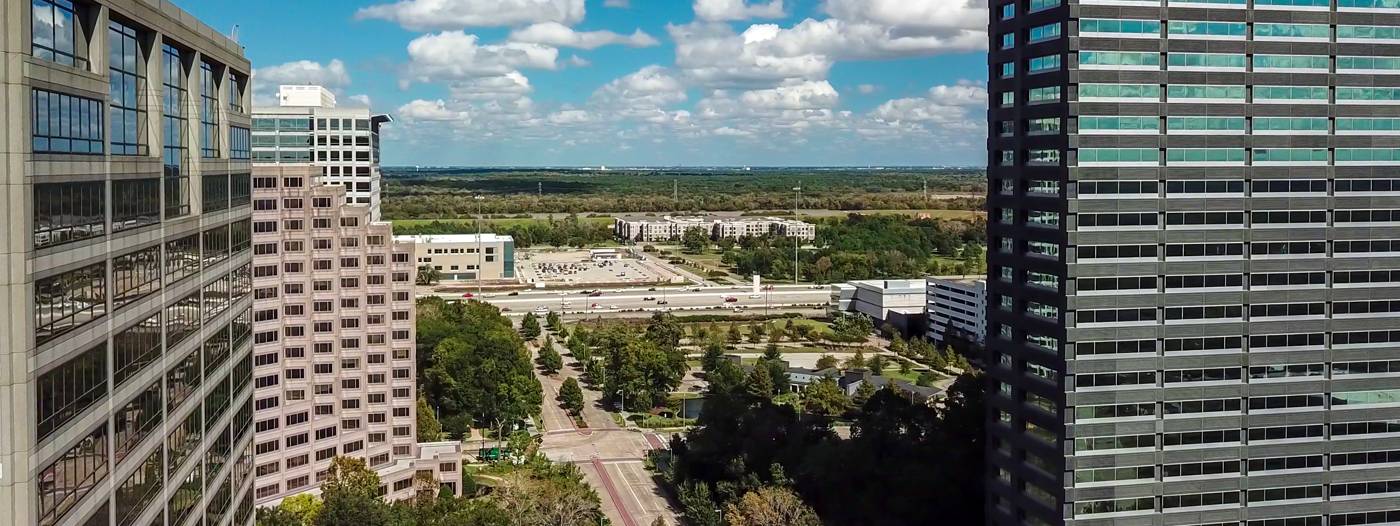Asian population growth spurs suburban Chinatown in Katy
24 Sep 2018
By: Paul Takahasi - Houston Chronicle
Restaurants in this sprawling new strip mall serve a smorgasbord of Pan-Asian cuisine, including Malaysian fried rice, Vietnamese noodle soup, Taiwanese boba tea and Japanese cream puffs.
One might think this Asian-themed plaza sits in the heart of Chinatown, for decades the cultural center of Houston’s fast-growing Asian community. However, this grocery-anchored shopping center is rising from the flat prairieland of Katy, some 20 miles west of Bellaire.
“We’re trying to bring a taste of Asia to the mainstream,” said Josie Lin, the center’s leasing representative. “I believe this is going to become another landmark, just like Chinatown.”
Katy Asian Town — which celebrates the grand opening Friday of its anchor tenant, Korean supermarket H Mart — represents one of the largest concentrations of Asian restaurants and shops outside of Houston’s Chinatown. The 150,000-square-foot retail development at the northeast corner of Interstate 10 and the Grand Parkway is poised to become a new Chinatown serving the growing number of Asian residents flocking to Houston’s western suburbs.
Asians represent the fastest-growing ethnic group in the U.S., growing 72 percent between 2000 and 2015 to 20.4 million, according to the Pew Research Center. In the Houston area, Asians and Asian-Americans are increasingly moving to the west Houston suburbs of Sugar Land, Katy and Cypress. Now, Asian retailers are following the growth of Asian rooftops on the west side. And they’re even drawing customers from Chinatown.
Jessica Vien, 25, lives in Chinatown, but has ventured out to Katy Asian Town twice this year to check out the new shops and restaurants. The University of Houston optometry student said the new shopping center likely won’t replace Chinatown, but will be a boon for Katy residents.
“They won’t have to drive as far,” Vien said. “I’m excited for more places to open here.”
H Mart this week opens its third Houston-area location in Katy Asian Town. The 47,000-square-foot supermarket will sell Korean staples such as banchan appetizers, spicy pickled kimchi and pre-marinated bulgogi beef. The New Jersey-based grocery chain, founded in 1982, operates 66 supermarkets nationally, including five in Texas.
Given its size, H Mart caps Katy’s emergence as a new hub for Asian business, though it isn’t the first Asian grocer to open on the west side in recent years.
In 2016, 99 Ranch Market, a California-based Taiwanese supermarket chain, opened on South Mason Road near Interstate 10 in Katy. Last year, California-based Japanese supermarket Seiwa Market opened off Dairy Ashford near the Energy Corridor. And just last month, z.Tao Marketplace, a Dallas-based Asian grocer, and Daiso, a Japanese dollar store, opened off South Mason Road in Katy.
Asian-owned retailers are following in the footsteps of its growing customer base in Katy, a once-rural, rice-farming town known today for its master-planned communities and Friday night football games.
U.S. Census data show the Asian population in Katy more than tripled between 2000 and 2010. Today, the city has about 40,000 Asian residents, and that figure is projected to grow to 50,000 by 2022, according to the Katy Area Economic Development Council. Asians currently represent about 15 percent of Katy Independent School District’s student population, compared with about 4 percent in the Houston Independent School District.
“People often talk about Mexican migration, but it’s slowing down and Asian migration is picking up,” said Nestor Rodriguez, a University of Texas at Austin sociology professor who lived in Houston for 24 years and has studied immigrant settlement patterns in the city. “The U.S. is going to be a Latino nation in the latter part of this century, but in the 22nd century, the U.S. is going to be an Asian nation.”
Asian families are attracted to the Katy area because of its well-regarded schools, its proximity to the Energy Corridor and affordable homes, said Gordon Quan, an immigration attorney and former Houston City Councilman.
“Katy checks all the boxes,” said Quan, founder of Quan Law Group. “If you want to find the Asian community, look for the good schools.”
Houston has a century-old history of creating new Chinatowns as Asian immigrants and their children have migrated increasingly westward.
The city’s first Asian business district opened in downtown during the early 1900s to serve some 250 Chinese immigrants who came to the Bayou City to work on the central Texas railroad.
By the 1930s, Houston’s original Chinatown formed around what is today called East Downtown. The “Old Chinatown” featured a number of Chinese grocery stores and restaurants, including the original Kim Son, and by the 1950s, the On Leong Chinese Merchants Association building was erected near where the George R. Brown Convention Center stands today.
However, the Asian population began migrating westward in the 1960s with the construction of U.S. 59 and downtown redevelopment. The Immigration and Nationality Act of 1965, which lifted longstanding restrictions on Asian immigration, and the fall of Saigon in 1975 brought a new wave of Asian immigrants and Vietnamese refugees to Houston. These new immigrants began to settle in the then-suburbs of Bellaire, Sharpstown and Spring Branch.
In 1983, the first Asian businesses opened in the “New Chinatown” along Bellaire and Beltway 8. Over the subsequent years, several major shopping plazas with Asian restaurants and shops were constructed in modern-day Chinatown, including Dun Huang Plaza and Hong Kong City Mall.
Katy now is drawing Asian retailers with its growing Asian population and abundance of inexpensive real estate. Sandwiched between a JC Penneys and the future campus of the University of Houston Katy, Katy Asian Town was developed to serve the growing number of Chinese, Filipino, Indian, Japanese, Korean, Pakistani and Vietnamese residents living in Sugar Land, Katy and Cypress, Lin said.
The first phase of the shopping center features H Mart and eventually 51 other restaurants, karaoke bars and shops, including longtime favorites such as Mala Sichuan Bistro and also several new-to-Houston franchises.
New concepts include Taiwanese tea shop Chatime, which has more than 2,500 locations globally; Taiwanese dessert shop MeetFresh, which has some 600 locations in China; and Japanese cream puff shop Beard Papa’s, which has more than 400 stores around the world; and Korean cosmetic stores Tony Moly and It’s Skin, which sells anti-wrinkle creams made from snail mucus that are popular across Asia.
The retail center is 60 percent leased, with 70 inquiries for the remaining space. Some of the grand openings for stores such as MeetFresh and Beard Papa’s have attracted lines of shoppers out the door.
Related: Japanese cream puff chain Beard Papa’s makes Texas debut in Katy
The second phase of Katy Asian Town will feature Taiwanese coffeehouse 85C° Bakery Café, Kura Revolving Sushi Bar and Japanese bookstore Kinokuniya, Lin said. Future phases could include condominiums, a medical complex and retirement homes.
“One of the benefits of this westward migration of Asians is there is more area for newer types of retail and food formats to develop,” said Milton Young, president of the Asian Chamber of Commerce in Houston. “Having a concentration of new concepts builds on itself, and we’ll see more of the Asian population migrate westward.”
Many U.S. cities have multiple Chinatowns catering to different waves of Asian immigrants and younger generations of Asian-Americans, said Fenggang Yang, a sociology professor at Purdue University who has studied Chinatowns across the country.
In New York City, there’s Chinatown in Manhattan, but there are Asian enclaves in Flushing, Queens and farther out in Fort Lee, New Jersey. In Chicago, there’s Chinatown just south of the downtown Loop, but there is Little Saigon in northern Uptown. In Los Angeles, there’s Chinatown, but Monterey Park has become a new kind of Chinatown, Yang said.
Outside of the U.S., Vancouver and Toronto each have three Chinatowns, Yang said.
These new suburban Chinatowns are not exclusively Chinese as their older counterparts, Yang said. Many of these business districts are Pan Asian, and Katy Asian Town reflects the diversity within the Houston Asian community. Lin said the Katy Asian Town is open to businesses of all backgrounds, not just Asian.
“You’ve got to get as many consumers as possible,” Yang said. “It’s better to be inclusive, than exclusive.”
Similar to other major cities, Houston can support multiple Chinatowns, especially if the city’s Asian population continues to grow, Rodriguez, the UT Austin professor, said.
Full Story
More Topics







